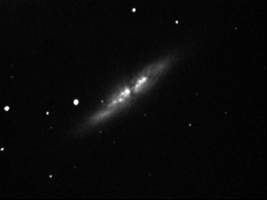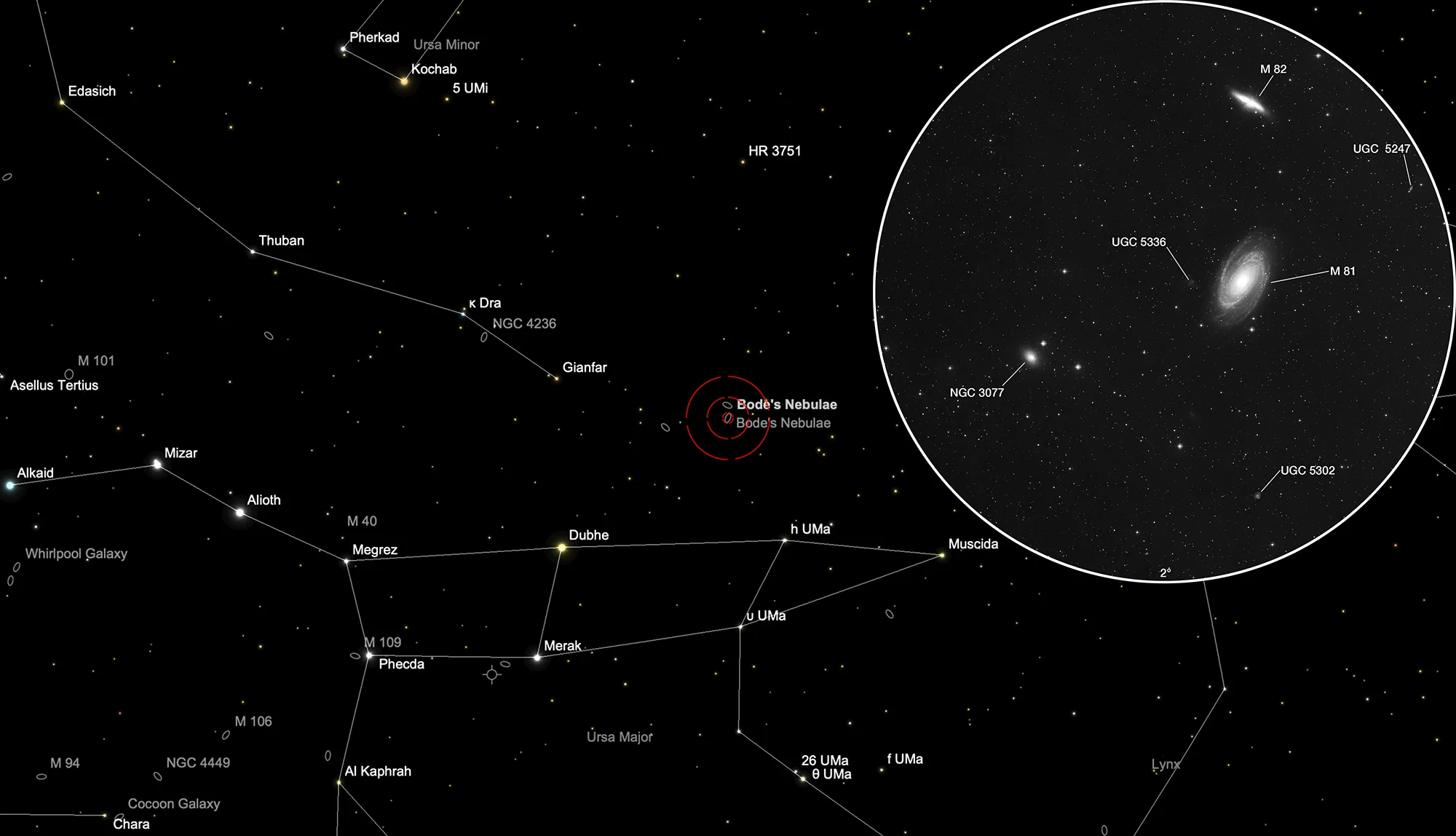Galaxies M 81, M82 & NGC 3077
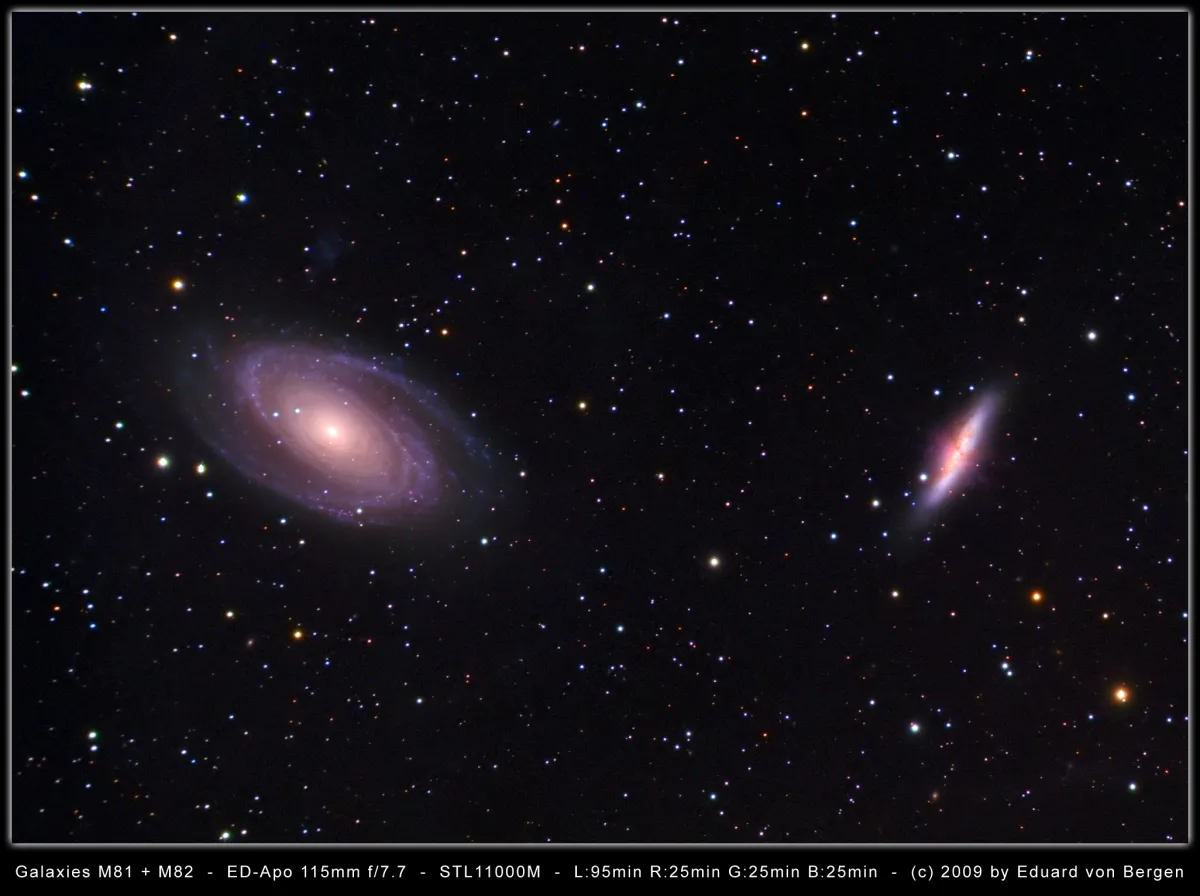
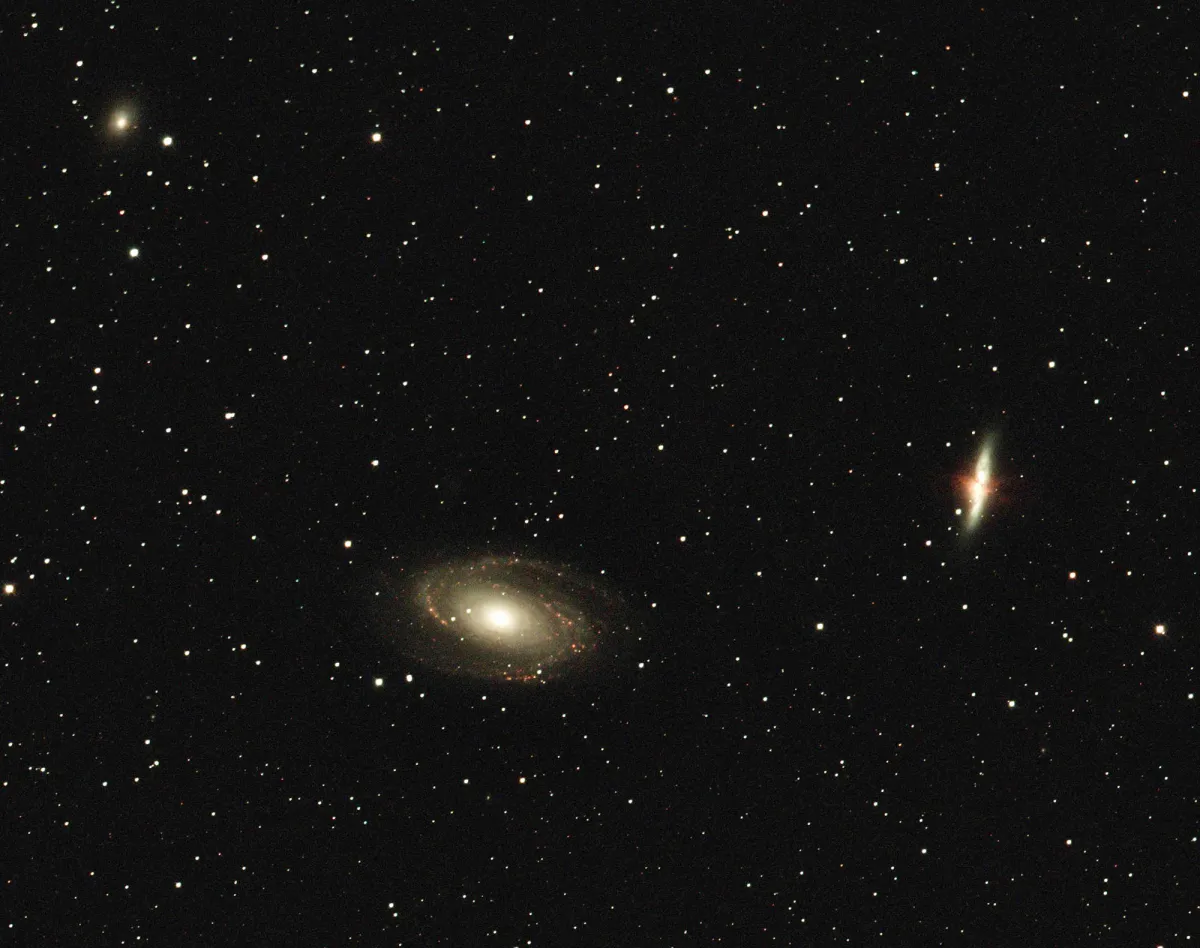
History
The well-known galaxy pair M 81 and M 82 was discovered by the Berlin astronomer J. E. Bode on 31 December 1774 - hence the somewhat less common name Bode's Nebula for M 81. A little over six years later, in February 1781, Charles Messier added these two galaxies to his famous list of nebulous objects. Lord Rosse compared M 81 with the Andromeda Nebula and discovered some dark bands of dust in M 82 for the first time. [4, 196, 277]
Physical Properties of M 81 (Bodes Galaxy)
In photographs from large telescopes, M 81 shows itself to be one of the most magnificent galaxies in the northern sky, remarkable for its strikingly symmetrical structure and dynamic appearance. The spiral windings surround a bright, egg yolk-shaped central mass, which undoubtedly consists of millions of insoluble, faint individual stars. In this bright central region there is an almost stellar core compression, which, however, cannot be seen in most of the photographs due to severe overexposure. The well-defined spiral arms are bounded on their inside by thin bands of dust, which can be followed on briefly exposed images up to 35 arc seconds close to the core. The arms themselves appear well dissolved in star clouds and nebulae.
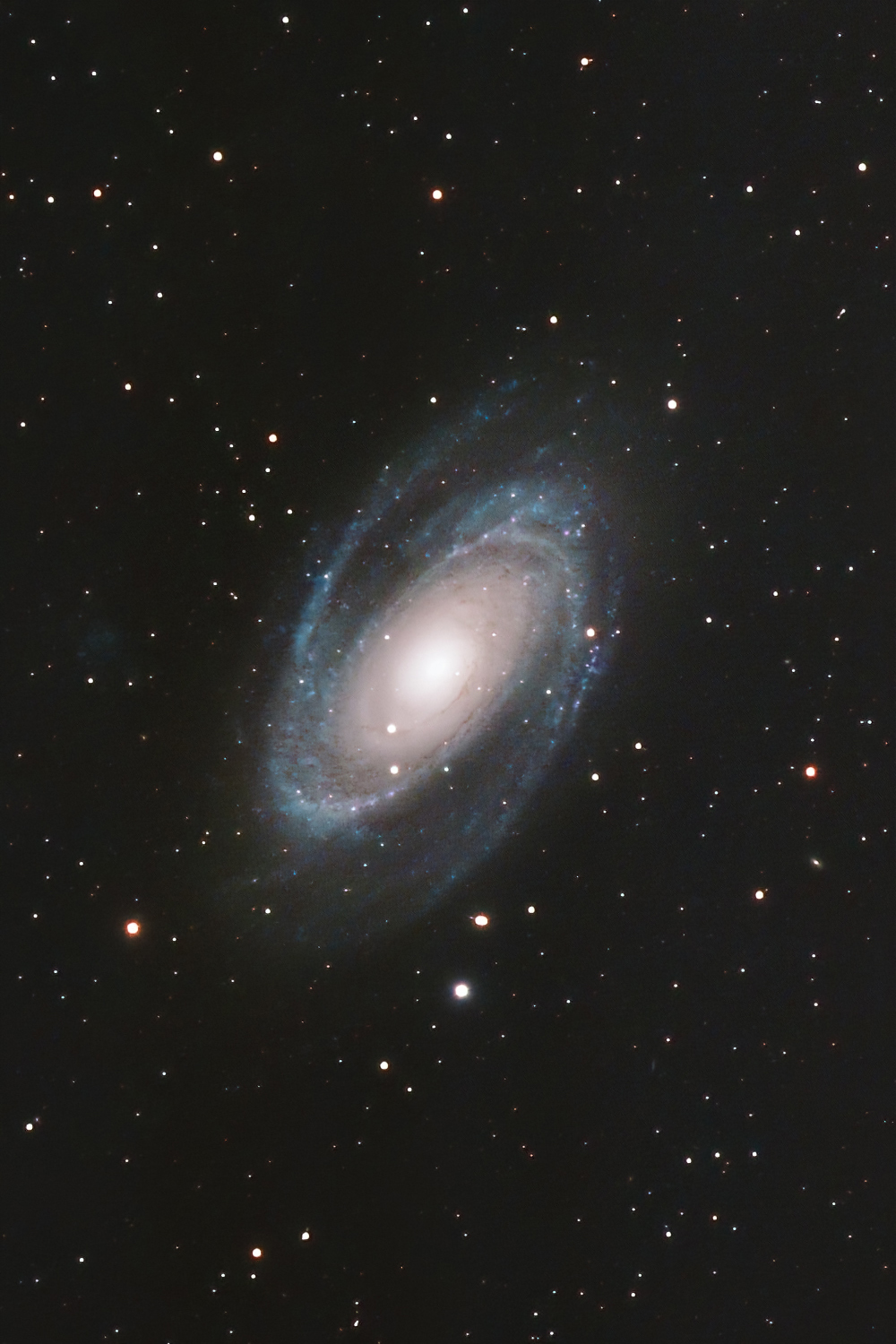
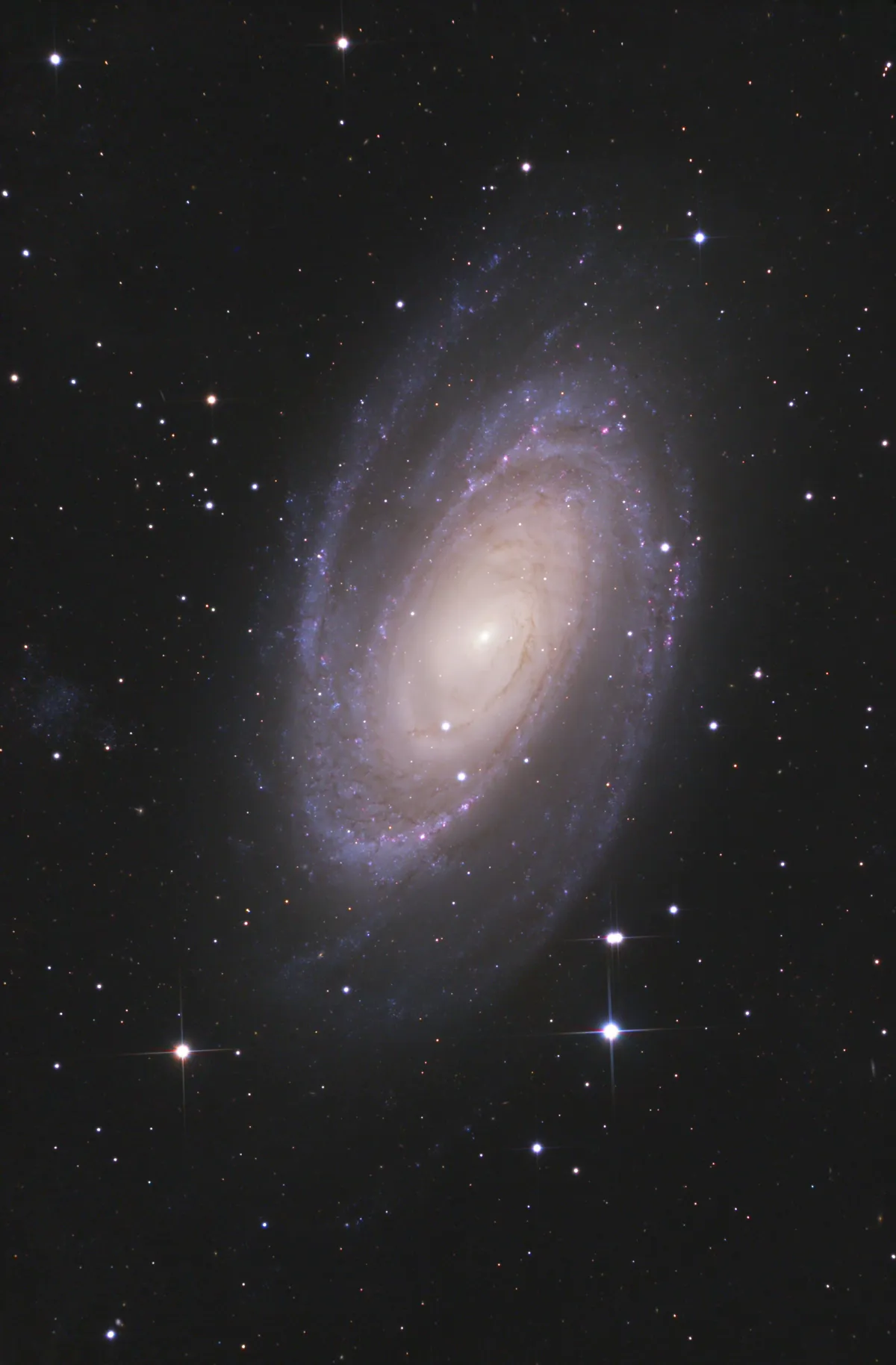

With a density of about 0.1 solar masses per cubic parsec, M 81 is one of the densest known galaxies. It has about twice the density of a typical spiral galaxy like the Andromeda Galaxy M 31, which is comparable in appearance. Well over a third of the mass seems to be concentrated in the central bulge.
The redshift of M 81 reveals its movement of about 42 km/s in the direction of our solar system. The distance was determined to be around 11 million light years with the help of the 32 Cepheids discovered by the Hubble Space Telescope. The inclination of the axis of rotation to our line of sight is 65 degrees.
M 81 shows traces of an interaction with the neighboring galaxies M 82 and NGC 3077. On images obtained with the Very Large Array radio telescope, weak bridges of interstellar gas can be seen between the three galaxies. A collision between M 81 and M 82 around 200 million years ago could be the cause. Immediately to the east of M 81 there is a weak compression of gas and stars called Holmberg IX. This shows similarity to the Magellanic Clouds, the two dwarf companion systems of the Milky Way. Presumably these were also caused by a collision.
On 28 March 1993, a supernova (SN 1993J) occurred in M 81. It was discovered by the Spanish amateur astronomer Francisco Garcia with his 25 cm telescope. At the time of its discovery, he estimated the SN to be 12 mag. 24 hours earlier, the SN could not be made out on a CCD image with the limit brightness of 16 mag of another amateur astronomer in France. About a month later, the Type IIb supernova reached a second maximum of 10.5 mag. The precursor of this supernova has been identified photographically with a K0 supergiant with 10 to 18 solar masses.
Physical Properties of M 82 (Cigar Galaxy)
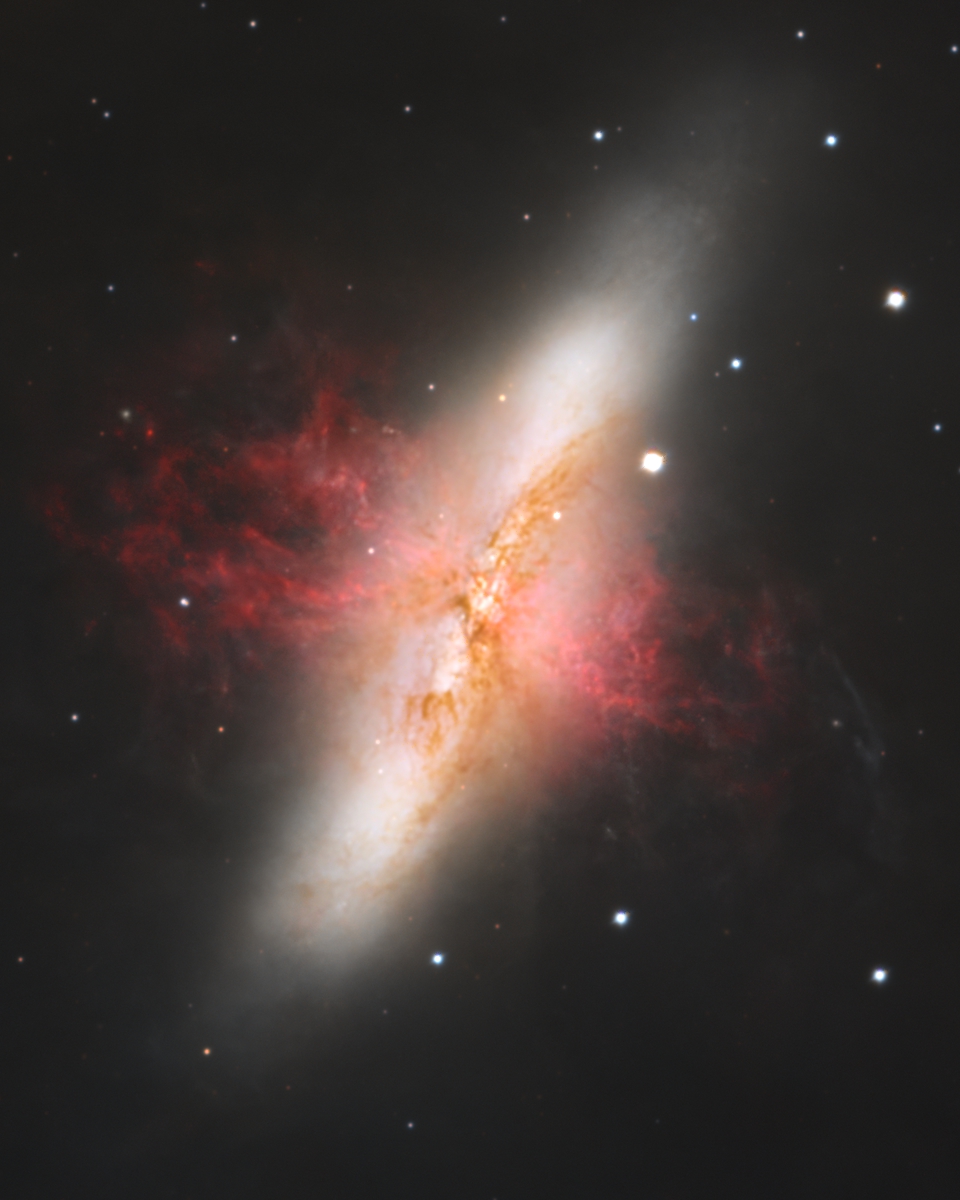
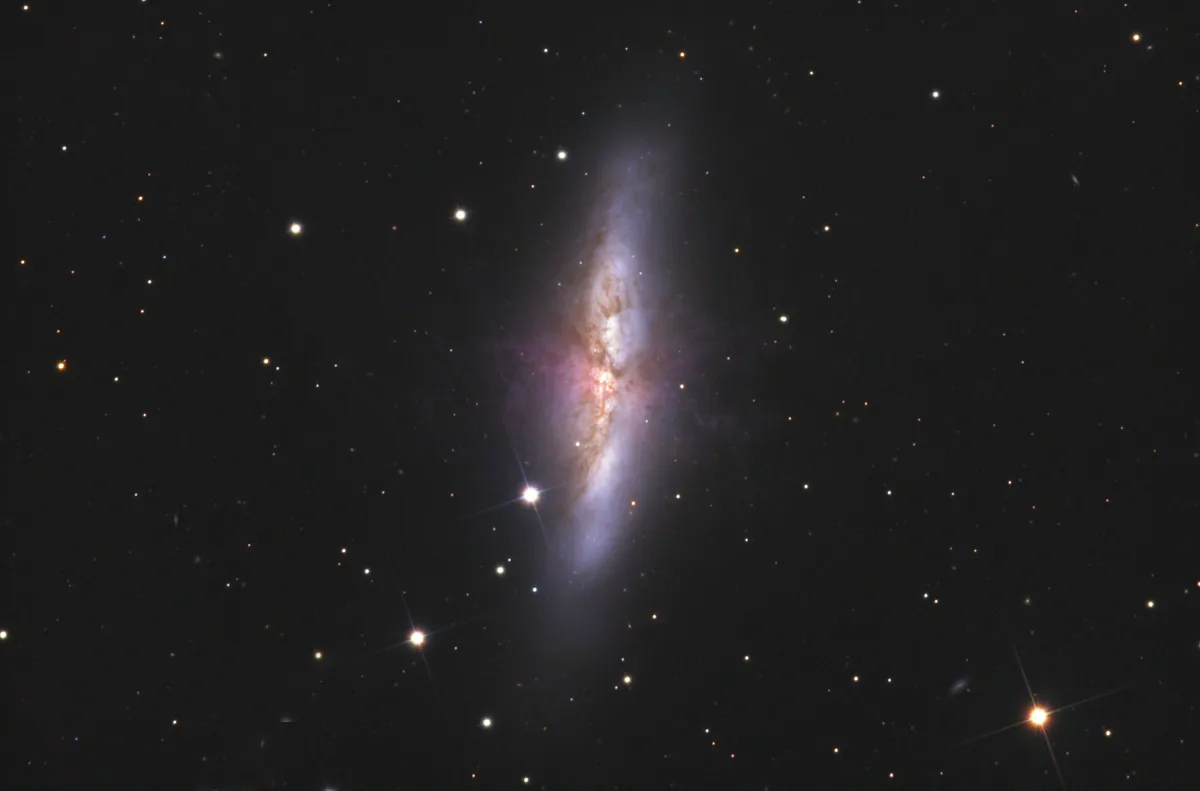
The galaxy M 82 is a peculiar object that can easily be mistaken for an edge-on spiral galaxy in small telescopes. Photographs with large telescopes, however, show an amorphous, extensive mass of rather misty appearance, divided into hazy strands and filaments along the edges and traversed by dark, irregular, light-absorbing clouds of dust. The integrated spectral type of this system is about A5, but colour measurements show that the outer areas are bluer than the central region. However, the entire colour index is equivalent to class G0. The discrepancy between the integrated spectral class and the colour index was assigned to a reddening of the starlight due to large amounts of dust in the galaxy. Another strange peculiarity is the strongly polarized light from parts of M 82, which suggests the presence of a strong magnetic field. In 1962, a strong radio source was first discovered in the core area of M 82. Today it is believed that these are the remains of numerous supernovae.
The filigree gas plumes, which are explosively directed radially from the centre about 10'000 light years out of the galaxy plane, are caused by two elongated gas bubbles that are oriented almost perpendicular to the disk of M 82 and touch each other in the core. It appears as if the filaments are following strong magnetic field lines. They also shine very strongly in the H-alpha range at 656.3 nm. Spectroscopic studies have shown that this matter is moving away from the centre of the galaxy at around 1000 km/s. But the speed decreases rapidly with increasing distance from the core. At a distance of 3500 light years it is only about 350 km/s. After another 1000 light years it is negligibly small. The total expanding mass was estimated to be around 5 million solar masses.
Presumably on a cosmic scale, only about 1.5 million years ago, a huge eruption occurred recently in the central region of M 82. This activity could have been triggered by gravitational disturbances from the neighboring galaxy M 81. Obviously, a starburst has started, in which a large number of new stars are formed in the galaxy's core within a short time. The heat and radiation generated in this way drive masses of gas and dust in the direction of the galaxy poles from the plane of the system into intergalactic space.
Physical Properties of Galaxy NGC 3077

The galaxy NGC 3077 is an irregular galaxy of the non-magellanic type (according to the Deep-Sky Field Guide to Uranometria). At LEDA, however, there is the specification of the Hubble type of «Sd», which is a spiral galaxy with very wide open spiral arms. Dreyer described the galaxy as quite bright and large, with a brighter centre and a round shape. NGC 3077 belongs to the same group as M 81 and M 82. There are even traces of an interaction with M 81.
M 81 and M82 form the centre of a small group of about ten other galaxies, including NGC 3077, NGC 2976, NGC 2366, IC 2574, Holmberg II and NGC 2403. At a distance of about 6.5 to 9 million light years, the M 81 Group next to the Sculptor group, possibly the closest to our local group.
| Name | RA | Dec | Type | bMag | vMag | B-V | SB | Dim | PA | z | D(z) | MD | Dreyer Description | Identification, Remarks |
|---|---|---|---|---|---|---|---|---|---|---|---|---|---|---|
| NGC 3031 | 09 55 33.5 | +69 04 02 | Gx (Sb) | 7.9 | 6.9 | 1.0 | 13.2 | 24.9 × 11.5 | 157 | -0.000113 | 3.690 | ! eB, eL, E 156°, gsvmbMBN | h 649; GC 1949=1953; M 81; UGC 5318; MCG 12-10-10; IRAS 09514+6918; KCPG 218A; CGCG 333-7; Bode's nebulae | |
| NGC 3034 | 09 55 54.0 | +69 40 59 | Gx (Sd) | 9.3 | 8.4 | 0.9 | 12.5 | 11.2 × 4.3 | 65 | 0.000677 | 2.86 | 3.780 | vB, vL, vmE (ray) | WH IV 79; GC 1950; M 82; UGC 5322; MCG 12-10-11; IRAS 09517+6954; KCPG 218B; CGCG 333-8; PRC D-13; Arp 337; 3C 231; Ursa Major A; Bode's nebulae |
| NGC 3077 | 10 03 20.3 | +68 44 06 | Gx (Sd) | 10.6 | 9.9 | 0.7 | 13.2 | 5.2 × 4.7 | 45 | 0.000047 | 0.20 | 3.560 | cB, cL, mbM, R with ray | WH I 286; h 658; GC 1982; UGC 5398; MCG 12-10-17; CGCG 333-13; IRAS 09592+6858; near SAO 15054 |
| PGC | RA | Dec | Type | Dim | Btot | HRV | PA | Names |
|---|---|---|---|---|---|---|---|---|
| PGC 28225 | 09 49 11.8 | +69 25 02 | S | 13.1 x 6.0 | 14.9 | 143 | 155 | UGC 5247, MCG 12-10-5, CGCG 332-66 |
| PGC 28563 | 09 54 21.9 | +68 20 00 | D | 1.9 x 1.7 | 14.7 | 4376 | UGC 5302, MCG 12-10-8, CGCG 333-5, IRAS 9503+6834 | |
| PGC 28757 | 09 57 32.5 | +69 02 35 | I | 2.5 x 2.0 | 14.6 | 47 | Holmberg IX, UGC 5336, MCG 12-10-12, DDO 66, ANON 953+69 |
Finder Chart
Since the pair of galaxies is located very far north in the sky, the search with equatorially mounted telescopes is a little more laborious. With some types of mounts, the two galaxies are even in the 'dead' area around the north celestial pole. But there is still a good trick: The 4.1 mag bright λ Draconis is the right of the two dragon stars above the box of the Big Dipper. It has roughly the same declination as the galaxy pair M81 and M82. The telescope is equipped with a large field eyepiece (about one to two degrees field of view), pointed at λ Draconis (Giansar) and then rotated about one and a half angular hours to the west in an anti-clockwise direction around the north celestial pole. The two galaxies are immediately visible in the field of view. The galaxies are circumpolar and are highest in the sky at night from November to July.
Visual Observation
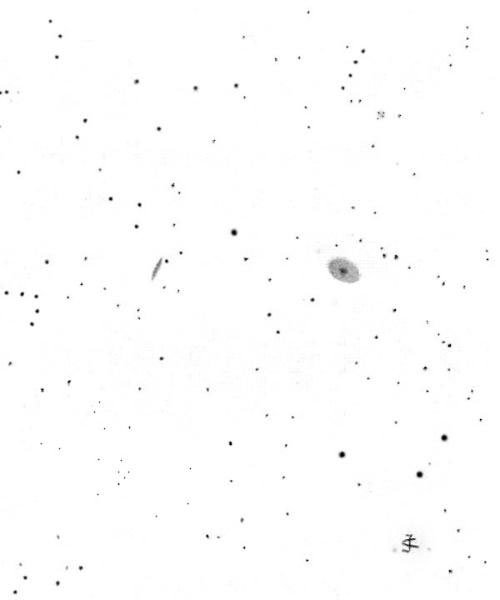
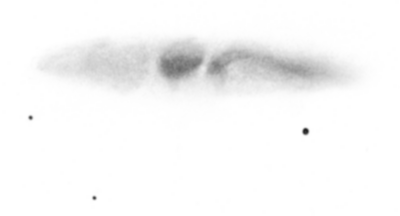
300 mm Aperture: The two galaxies M 81 and M 82 are already noticeable at a low magnification of about 25 times in the field of view and are therefore unmistakable. M 81 appears much brighter and larger than M 82 and shows a stellar core. In neither of the two galaxies, however, can any structures be seen. If you zoom in about 50 times, you think you can see a small asterisk in the bright central area of M 82, which, however, can no longer be verified with increasing magnification. The first structures of the dust bands can be seen in M 82 from a magnification of about 80 times. The visibility of the dust bands increases with the magnification. The optimum turns out to be about 300 times. The galaxy M 81, which looks so beautifully filigree in the photographs, offers a rather disappointing sight at every enlargement: Neither the spiral arms nor the fine dust bands can be seen. The galaxy appears only as an elliptical diffuse spot with a stellar centre. The smaller galaxy NGC 3077 can easily be overlooked at a magnification of around 25 times, but is easily recognizable from 50 times. It appears round with an increase in brightness towards the centre. — 1997, Bernd Nies
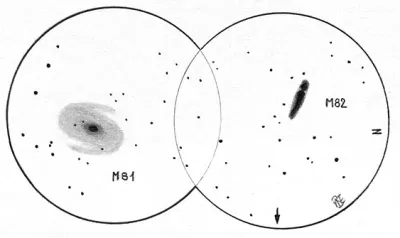
320 mm Aperture: With a good view of the M 81, its two fine, tapering spiral arms are also visible. The many bright foreground stars help to reliably verify the exact course. A medium to smaller magnification is to be used for the spiral arms, but this in turn requires a black, unlit sky. The nearby galaxy M 82 shows itself in the edge position. The two dark cuts in the M 82, which can already be seen with smaller telescopes, are noticeable. In the middle and larger ones, further, fine structures become visible. [192] — 12.5" Ninja-Dobson, F:4.5 / TV-Nagler 13mm, 111x, 0.74° Eduard von Bergen
762 mm Aperture: The visual impression of M 81 and M 82 can be reproduced with a MallinCam video camera and an integration time of around three seconds. A tracking 30" f/3.3 SlipStream Dobsonian was used. The resulting image comes very close to visual vision with a 13 mm Tele Vue Ethos eyepiece. — 14. 3. 2012, Eduard von Bergen
762 mm Aperture: The dwarf galaxy Holmberg IX or UGC 5336 is an extremely faint companion galaxy of M 81. At the medium magnification of 360x for the 30" Dobsonian, only a hint of an almost «nothing» can be guessed. The already faint dwarf galaxy is located one third to the left on the base line of a clearly recognizable star triangle. — 30" SlipStream-Dobson f/3.3, Hasliberg, SQM 21.23, 5. 2. 2024, Elena and Eduard von Bergen

